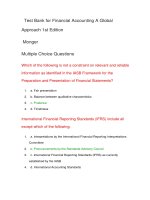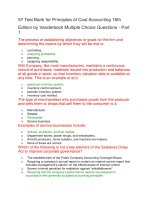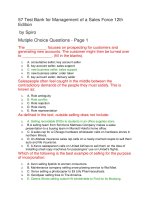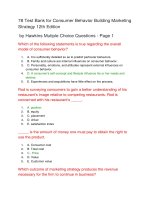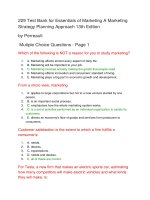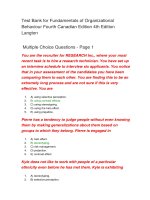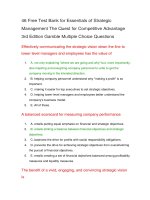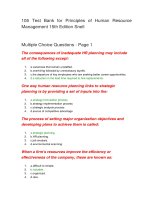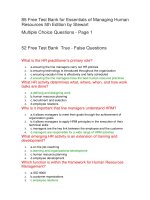57 test bank for management of a sales force 12th edition
Bạn đang xem bản rút gọn của tài liệu. Xem và tải ngay bản đầy đủ của tài liệu tại đây (42.22 KB, 12 trang )
57 Test Bank for Management of a Sales Force 12th
Edition
by Spiro
Mutiple Choice Questions - Page 1
The __________ focuses on prospecting for customers and
generating new accounts. The customer might then be turned over
to ______________. (fill in the blanks).
1.
2.
3.
4.
5.
A. consultative seller; key account seller
B. key account seller; sales support
C. new business seller; sales support
D. new business seller; order taker
E. key account seller; delivery seller
Salespeople often feel caught in the middle between the
contradictory demands of the people they must satisfy. This is
known as:
1.
2.
3.
4.
5.
A. Role ambiguity
B. Role conflict
C. Role rejection
D. Role clarity
E. Role representation
As defined in the text, outside selling does not include:
1.
2.
A. Selling recordable DVDs to students in an office supplies store.
B.A selling team from Simmons Mattress Company makes a sales
presentation to a buying team in Marriott Hotel's home office.
3. C. A sales rep for a Chicago hardware wholesaler calls on hardware stores in
northern Illinois.
4. D. An Allstate insurance sales rep calls on a newly-married couple to sell them
auto and life insurance.
5. E. A Xerox salesperson calls on United Airlines to sell them on the idea of
installing small copy machines for passengers' use on United's flights.
Which of the following is the best example of selling for the purpose
of incorporation:
1.
2.
3.
4.
5.
A. Avon selling lipstick to women consumers.
B. Maintenance company selling snow plowing service to Wal Mart.
C. Xerox selling a photocopier to Eli Lilly Pharmaceuticals.
D. Goodyear selling tires to Tire America.
E. Owens Illinois selling custom-fit windshields to Ford for its Mustang.
Which of the following types of jobs is an order-getter?
1.
2.
3.
4.
5.
A. Xerox rep selling an office-copier system to United Airlines.
B. Pepsi-Cola delivery seller with a route in Birmingham, Alabama.
C. Sales engineer for Boeing Airplane Company.
D. Missionary sales rep for Lilly pharmaceuticals, calling on physicians.
E. Retail sales clerk in a department store.
In the text book's classification of types of sales jobs, the one
involving the most complex problem solving is likely to be:
1.
2.
3.
4.
5.
A. Consultative sellers.
B. New business sellers.
C. Sales support salespeople.
D. Delivery sellers.
E. Order takers.
A salesperson whose main job is to deliver a product to retailers or
household consumers – Pepsi Cola, fuel oil, milk, for example –
ordinarily is classified as a:
1.
2.
3.
4.
5.
A. Consultative salesperson.
B. Delivery seller.
C. Key account seller.
D. Missionary sales rep.
E. Sales engineer.
Value added components are:
1.
2.
3.
4.
5.
A. Sales promotion giveaways.
B. Things such as service which enhance the product.
C. Parts or equipment that are added to the product.
D. Usually include only insurance and delivery.
E. None of these are value added components.
The new type of salesperson that has emerged in recent years is a
professional salesperson who is essentially a(n):
1.
2.
3.
4.
5.
A. Order-taker.
B. Manipulative seller.
C. Backslapping, joke-teller.
D. Marketing consultant.
E. All of these.
Today, to be successful as a sales manager, _________ skills are
more important than ________________ skills.
1.
2.
3.
A. analytical; technology
B. evaluative; people
C. people; analytical
4.
5.
D. technology; people
E. evaluative; analytical
The job of a missionary salesperson might involve:
1.
2.
A. Technical selling as in a sales engineer's job.
B.Such activities as setting up promotional displays and working with retailers'
or wholesalers' sales forces, but not soliciting orders.
3. C. A high level of creative selling.
4. D. A considerable amount of order taking.
5. E. None of these.
Sales jobs differ from other jobs because:
1.
2.
3.
4.
5.
A. Salespeople do not spend company funds.
B. Salespeople have small role sets.
C. Salespeople have greater role ambiguity.
D. Salespeople have a lot of supervision.
E. Salespeople do not represent the customer.
Our definition of an outside sales force includes all of the following,
EXCEPT:
1.
2.
3.
4.
5.
A. Firestone salespeople selling tires to Ford.
B. State Farm agents selling life insurance to consumers.
C. Salespeople selling culinary knives door-to-door.
D. Telemarketers selling mortgages to home owners.
E. Sal-Mart clerk selling MP3 player to consumer.
All of the following are common responsibilities of today's sales
managers, EXCEPT:
1.
2.
3.
4.
5.
A. hiring and training.
B. territory design.
C. forecasting and budgeting.
D. performance evaluation.
E. product design.
The Internet is used by salespeople for:
1.
2.
3.
4.
5.
A. Prospecting
B. Product development
C. Placing orders
D. Competitive reporting
E. All of these
Which of the following types of sales jobs are maintenance
salespeople that facilitate sales to consumers or business accounts
that have already been established?
1.
A. New business seller.
2.
3.
4.
5.
B. Consultative seller.
C. Inside order-taker.
D. Delivery sellers.
E. Key account sellers.
Which of the following is the best example of a missionary
salesperson?
1.
2.
3.
4.
5.
A. Person whose main job is to contact customers by telephone, fax machine,
or computer.
B. Pharmaceutical rep calling on doctors.
C. Rep for a sporting goods wholesaler who calls on sporting goods stores.
D. Travel agent that arranges and conducts tours, including driving the tour
bus.
E. Rep who delivers cases of Coca-Cola from bottler to local stores.
Consultative salespeople:
1.
2.
3.
4.
5.
A. focus generating new accounts.
B. are creative, problem-solvers.
C. are a type of sales support salesperson.
D. seldom take orders.
E. All of these.
A company's marketing mix ordinarily does not include its:
1.
2.
3.
4.
5.
A. Suppliers.
B. Advertising program.
C. Sales force management.
D. Pricing policies.
E. Product assortment.
An element of a company's marketing mix that is not part of its
communications mix is:
1.
2.
3.
4.
5.
A. Distribution.
B. Advertising.
C. Sales promotion.
D. Personal selling.
E. Publicity.
When a student goes to the college book store to buy a sweatshirt,
the type of selling involved in the situation is called:
1.
2.
3.
4.
5.
A. Telemarketing.
B. Across-the-counter selling.
C. Outside selling.
D. Inside/outside selling.
E. Going-to-the-customer selling.
According to the textbook, which of the following does not represent
features of a sales job?
1.
2.
3.
4.
5.
A. The authorization to spend company funds.
B. Representing customers to their companies.
C. Implementation of a firm's marketing strategies in the field.
D. A and B only.
E. None of these.
Reps are not supervised very closely, so they:
1.
2.
3.
4.
5.
A. experience conflict
B. experience role ambiguity.
C. have large role sets.
D. frequently face rejection.
E. are authorized to spend company funds.
The promotional mix in a firm is least likely to include decisions
relating to:
1.
2.
3.
4.
5.
A. Sales promotion.
B. Pricing determination.
C. Personal selling activities.
D. Advertising.
E. Managing a sales force.
Most commonly, sales executives play a key role in all of the
following, EXCEPT:
1.
2.
3.
4.
5.
A. Selecting a sales force.
B. Strategic planning for the organization.
C. Forecasting sales force motivation and territory design.
D. Selecting the product's distribution channel.
E. Motivating salespeople.
According to the textbook, which of the following represents
features of a sales job?
1.
2.
3.
4.
5.
A. The authorization to spend company funds.
B. Representing customers to their companies.
C. Implementation of a firm's marketing strategies in the field.
D. All of these.
E. A and B only.
Sales executives are often responsible for:
1.
2.
3.
4.
A. Selecting a sales force.
B. Strategic planning, forecasting, sales and cost analysis.
C. Sales force motivation and territory design.
D. A and C only.
5.
E. All of these.
Today, for most companies, the number of competitors has ______,
while the number of suppliers has ______.
1.
2.
3.
4.
5.
A. Increased, increased.
B. Decreased, decreased.
C. Increased, decreased.
D. Decreased, increased.
E. None of these.
Relationship selling is:
1.
2.
3.
A. Building long term telemarketing associations.
B. The sole responsibility of the sales manager.
C. Building long term associations with a select number of carefully chosen
accounts.
4. D. Building short term associations with a large number of accounts.
5. E. Reminiscent of the back-slapping, joke-telling salesman of days gone by.
Which of the following best describes the scope and focus of the
textbook used in this course?
1.
2.
3.
4.
5.
A. Management of a company's promotion mix.
B. Management of all personal selling activities.
C. Management of a manufacturer's sales force.
D. Management of an outside sales force.
E. Management of a retailer's sales force.
57 Free Test Bank for Management of a Sales Force
12th Edition by Spiro Mutiple Choice Questions - Page 2
The fact that a person is an outstanding sales representative does
not necessarily mean that he or she would make a good sales
manager because:
1.
2.
3.
A. Most sales executives come from non-selling backgrounds.
B. Salespeople have no experience in planning.
C.Personality traits needed to be a good salesperson are totally different from
those needed to be a good manager.
4. D. The art of administration is a distinct skill, separate from technical ability.
5. E. The original statement is false; that is, the best salespeople actually make
the best managers.
In a company, the title "sales manager" may be applied to:
1.
2.
3.
A. A divisional manager responsible for sales in several districts.
B. The vice president of sales.
C. The head of the field sales force.
4.
5.
D. Any of the above.
E. Only two of A-B-C above.
With one exception, the following reflect the international situation
facing United States sales managers through the 21st century.
Which one is the exception?
1.
2.
3.
4.
5.
A. American firms are likely to face increased competition from Asian
companies.
B. Growth for most U.S. companies will have to come from within our own
borders.
C.Competition from an economically united European Community is likely to
be stronger than it was before unification.
D. There is a general trend of trade barriers between countries being
eliminated.
E. All of these are correct; that is, there is no exception.
Excellent salespeople may not make good sales managers
because:
1.
2.
3.
4.
5.
A.Some of the traits and skills needed to be a good sales rep are different
from those needed to be a successful manager.
B.Top salespeople, when promoted to management, always expect too much
from the people working under them.
C. Salespeople don't respect a boss who has had no previous managerial
experience.
D.As a manager, the former sales rep does not spend enough time in the field
working with the sales force.
E. None of these is correct.
Today, the most successful sales managers are seen as
_________________ rather than ______________ .
1.
2.
3.
4.
5.
A. directors; team leaders
B. controllers; bosses
C. team leaders; bosses
D. bosses; directors
E. team leaders; collaborators
Regarding the management of an increasingly diverse sales force,
sales executives should recognize that:
1.
2.
A. Female sales reps are rarely successful.
B.To remain competitive, sales managers need to capitalize on the strengths
of everyone in our diverse population.
3. C. Sales forces are becoming younger and younger.
4. D.Recruiting minority salespeople has always been easy – yet sales
managers have been reluctant to do it.
5. E. Women represent only a small percentage of sales workers.
With respect to the concept of administration, it is generally correct
to say that:
1.
2.
3.
A. Management is a skill that can be learned.
B. Administration is an activity that is quite different from management.
C.People who are technically skilled in performing a given activity make good
administrators in that field.
4. D.The fundamentals of administration in one field are usually different from
the administrative principles in another field.
5. E. None of these is correct.
Which of the following is an incorrect statement regarding the new
dimensions of sales management and personal selling?
1.
2.
3.
4.
5.
A. There is a significant increase in the number of women going into industrial
selling.
B. Customers are becoming increasingly demanding.
C. Territorial profit responsibility is moving from the salesperson to top
management.
D. Computer technology has a considerable impact on many areas of sales
force management.
E. All of these are correct.
The sales job is unique in that:
1.
2.
3.
4.
5.
A. Salespeople require no supervision.
B. Salespeople are entirely self-motivated.
C. Salespeople have especially small role sets.
D. Salespeople often feel caught in the middle between conflicting demands.
E. Salespeople work fewer hours per week than most other occupations.
Which of the following best describes the new breed of professional
salesperson?
1.
2.
3.
4.
5.
A. a professional salesperson who is also a marketing consultant.
B. cigar-smoking, backslapping, joke-telling salesperson.
C. a highly motivated, manipulative sales rep.
D. an order-taking, maintenance salesperson.
E. an order-getting, cold-calling salesperson focused on new accounts.
Which of the following terms best describes the new breed of
professional salesperson?
1.
2.
3.
4.
5.
A. Missionary sales rep.
B. Sales engineer.
C. Territorial marketing manager.
D. A rep who services his or her customers.
E. Consultative sales rep.
A useful generalization regarding the concept of administration is
that:
1.
2.
A. Management is an inherent trait; that is, it rarely can be learned.
B. Administration is a distinct skill, separated from technical ability in a given
field.
3. C. Good managers are born, not made.
4. D. To be a good manager of a given activity, you have to be technically skilled
in that activity.
5. E. The job of a sales executive usually is that of a manager, not an
administrator.
The sales job is different from other types of jobs in that normally a
salesperson:
1.
2.
A. Receives more direct supervision than do other workers.
B. Requires more social intelligence than other employees on the same level
in the organization.
3. C. Requires less motivation.
4. D. Works shorter hours than most other employees.
5. E. Is under less psychological pressure than most other employees.
Which of the following is an incorrect statement regarding the new
dimensions of sales management and personal selling?
1.
2.
3.
4.
5.
A. There is a significant increase in the number of women going into industrial
selling.
B. There is a growing expertise among purchasing agents.
C. There is a trend away from assigning territorial profit responsibility to
individual salespeople.
D. Computer technology has a considerable impact on many areas of sales
force management.
E. All of these are correct.
Which of the following is true about U.S. organizations:
1.
2.
3.
A. The market for many of their products has reached the saturation point.
B. They face increasing competition from foreign firms.
C. They face a general trend of the elimination of trade barriers between
countries.
4. D. Many of them earn the majority of their revenues outside the U.S.
5. E. All of these.
In preparation for the competitive environment throughout the 21st
century, sales managers must:
1.
2.
3.
A. Improve their management skills.
B. Develop an international perspective.
C. Make effective use of technology.
4.
5.
D. Do all of these.
E. Do only two of A-B-C above.
In team sales, the management position most likely to be eliminated
is the:
1.
2.
3.
4.
5.
A. District sales manager.
B. Sales supervisor.
C. Client team leader.
D. Vice president of sales.
E. National sales manager.
According to a recent survey, about ____________ of all
organizations have already deployed or are in the processing of
implementing a customer relationship management (CRM)
program.
1.
2.
3.
4.
5.
A. 10%
B. 33%
C. 50%
D. 67%
E. 90%
Customer Relationship Management refers to a program designed
to:
1.
2.
3.
4.
5.
A. Establish new accounts.
B. Manage the expenses of calling on customers.
C. Expand the relationships with existing customers.
D. Manage the distribution of goods and services to customers.
E. Minimize company liability with regard to the products it sells to customers.
About ______ percent of the civilian working-age population is
employed in sales occupations:
1.
2.
3.
4.
5.
A. 2.
B. 5.
C. 12.
D. 25.
E. 33.
In contrast to office or factory jobs, people in sales jobs are more
likely to:
1.
2.
3.
4.
5.
A. Represent their company to customers and to society in general.
B. Work under close supervision.
C. Be authorized to spend company money.
D. All of these are correct.
E. Only two of A-B-C are correct.
The cost of managing and operating a sales force (that is, the total
expenses related to salespeople) is estimated to be _____ percent
of total net sales.
1.
2.
3.
4.
5.
A. 3–4.
B. 8–10.
C. 15–20.
D. 25–33.
E. None of these is even close.
With respect to the importance of sales force management:
1.
2.
A. It is unnecessary if a company has truly adopted the marketing concept.
B. The cost of maintaining a sales force is much lower than advertising
expenses.
3. C.It is important because in most firms the sales force and their bosses are
critical to the success of carrying out marketing plans.
4. D.Students typically are not involved in sales management activities until they
have been out of school for many years.
5. E. It is more important than marketing management.
In firms which use a team selling approach, the first managerial
type position is usually:
1.
2.
3.
4.
5.
A. District sales manager.
B. Sales supervisor.
C. Client team leader.
D. Branch manager.
E. National sales manager.
In which of the following managerial activities is a sales manager's
job likely to be different from other management jobs?
1.
2.
3.
4.
5.
A. Training the salespeople.
B. Motivating the sales force.
C. Monitoring a sales rep's ethical behavior.
D. Communicating with salespeople.
E. All of these are likely to be different.
When selecting salespeople to promote to sales management, all of
the following are important qualities to look for, EXCEPT:
1.
2.
3.
4.
5.
A. A willingness to share information
B. Structured work habits
C. Skill at selling internally
D. Ego that is not overinflated.
E. An individualistic, "lone wolf" mentality.
Due to the use of selling teams, firms may
1.
2.
3.
4.
5.
A. Have more cross-functional communication.
B. Eliminate middle management positions.
C. Be flatter.
D. All of these.
E. None of these.

